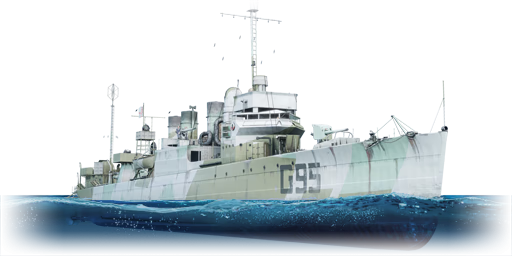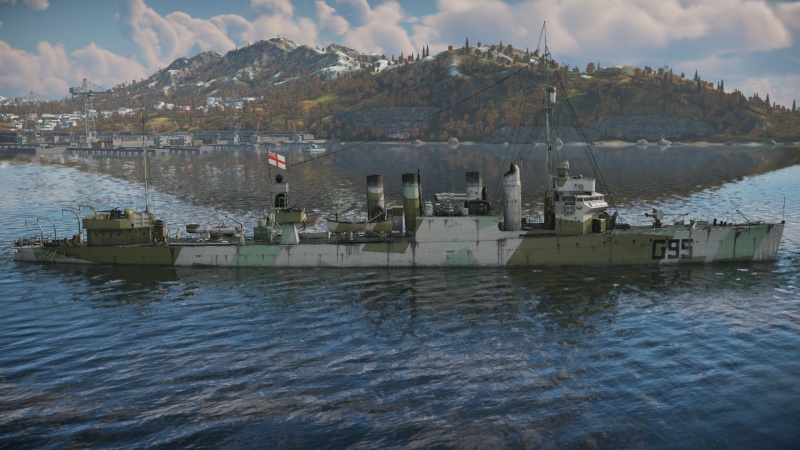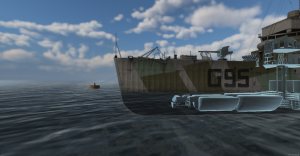Difference between revisions of "HMS Montgomery"
Colok76286 (talk | contribs) (Edits) |
(→Pros and cons) |
||
| Line 142: | Line 142: | ||
* Premium bonuses | * Premium bonuses | ||
* Thin hull and manoeuvrable, a menace for coastal areas | * Thin hull and manoeuvrable, a menace for coastal areas | ||
| − | * Multipurpose shells: Shrapnel can be used as aircraft | + | * Multipurpose shells: Shrapnel can be used as an aircraft deterrent |
'''Cons:''' | '''Cons:''' | ||
| Line 149: | Line 149: | ||
* Very limited amount of torpedoes | * Very limited amount of torpedoes | ||
* Poor top speed, unable to keep up with most Rank II destroyers | * Poor top speed, unable to keep up with most Rank II destroyers | ||
| − | * Unreliable crew count, won't be able to endure prolonged duels | + | * Unreliable crew count, won't be able to endure prolonged duels |
== History == | == History == | ||
Revision as of 16:56, 31 October 2022
Contents
Description
The Town-class, HMS Montgomery (G95), 1941 is a premium rank I British destroyer with a battle rating of 3.3 (AB/RB/SB). It was introduced in Update "New Power".
HMS Montgomery, pennant number G95, part of the Town class is a destroyer provided to the Royal Navy by the United States Navy, during the early stages of the Second World War. Originally known as USS Wickes (DD-75), as the lead ship of the Wickes class.
Despite her resemblance with HMS Churchill, the Montgomery is moderately more self-sufficient in combat against other reserve destroyers, thanks to the preservation of 3 high-calibre guns. Though, unfortunately, this comes as a trade-off for the support armament of HMS Churchill. Other than these slight main armament changes, the Montgomery retains the same problematic aspects like modest crew count, low top speed and insufficient variety of secondary armaments. Therefore, players should decide whether this support/combat destroyer gameplay is more appealing than the escort role of the Churchill.
Unquestionably, Montgomery's premium status and decent combat characteristics ensure an effective way to research the early British Bluewater fleet, but if a player is more inclined to firepower than versatility, then consider purchasing HMS Verdun instead.
General info
With a large black-coloured G95 pennant number painted towards the bow and various green tones with white highlights along a dark green upper deck, she can be distinguished from the HMS Churchill and the other United States' Clemson class destroyers.
Some distinguishing traits are the low freeboard distance on the stern and four funnels placed at the same height close to each other, with the pairs only divided by a superstructure aftwards of the bridge; this superstructure also settles two of the 102 mm guns.
Although being less combat-worthy than other destroyers, the Montgomery's armament of three 102 mm cannons was conserved for surface defence and convoy support; especially to defend from raiding submarines and German S-boots. Not exactly meant to fight alone against dedicated combat destroyers.
Survivability and armour
Talk about the vehicle's armour. Note the most well-defended and most vulnerable zones, e.g. the ammo magazine. Evaluate the composition of components and assemblies responsible for movement and manoeuvrability. Evaluate the survivability of the primary and secondary armaments separately. Don't forget to mention the size of the crew, which plays an important role in fleet mechanics. Save tips on preserving survivability for the "Usage in battles" section. If necessary, use a graphical template to show the most well-protected or most vulnerable points in the armour.
Mobility
Write about the ship's mobility. Evaluate its power and manoeuvrability, rudder rerouting speed, stopping speed at full tilt, with its maximum forward and reverse speed.
| Mobility Characteristics | |||
|---|---|---|---|
| Game Mode | Upgrade Status | Maximum Speed (km/h) | |
| Forward | Reverse | ||
| AB | |||
| Upgraded | 61 | 26 | |
| RB/SB | |||
| Upgraded | 50 | 22 | |
Modifications and economy
Armament
Primary armament
| Penetration statistics | |||||||
|---|---|---|---|---|---|---|---|
| Ammunition | Type of warhead |
Penetration @ 0° Angle of Attack (mm) | |||||
| 1,000 m | 2,500 m | 5,000 m | 7,500 m | 10,000 m | 15,000 m | ||
| 4 inch HE | HE | 11 | 11 | 11 | 11 | 11 | 11 |
| 4 inch SAP | SAP | 90 | 72 | 51 | 37 | 28 | 24 |
| 102 mm shrapnel | Shrapnel | 5 | 5 | 5 | 5 | 5 | 5 |
| Shell details | |||||||||
|---|---|---|---|---|---|---|---|---|---|
| Ammunition | Type of warhead |
Velocity (m/s) |
Projectile mass (kg) |
Fuse delay (s) |
Fuse sensitivity (mm) |
Explosive mass (TNT equivalent) (g) |
Ricochet | ||
| 0% | 50% | 100% | |||||||
| 4 inch HE | HE | 805 | 14.06 | 0 | 0.1 | 721 | 79° | 80° | 81° |
| 4 inch SAP | SAP | 805 | 15.2 | 0.015 | 5 | 520 | 47° | 60° | 65° |
| 102 mm shrapnel | Shrapnel | 805 | 17.7 | 0 | 0.1 | 218 | 62° | 69° | 73° |
Secondary armament
| Penetration statistics | |||||||
|---|---|---|---|---|---|---|---|
| Ammunition | Type of warhead |
Penetration @ 0° Angle of Attack (mm) | |||||
| 1,000 m | 2,500 m | 5,000 m | 7,500 m | 10,000 m | 15,000 m | ||
| HC Mk.27 | HE | 8 | 8 | 8 | 8 | 8 | 8 |
| Shell details | |||||||||
|---|---|---|---|---|---|---|---|---|---|
| Ammunition | Type of warhead |
Velocity (m/s) |
Projectile mass (kg) |
Fuse delay (s) |
Fuse sensitivity (mm) |
Explosive mass (TNT equivalent) (g) |
Ricochet | ||
| 0% | 50% | 100% | |||||||
| HC Mk.27 | HE | 823 | 5.9 | 0 | 0.1 | 500 | 79° | 80° | 81° |
Anti-aircraft armament
An important part of the ship's armament responsible for air defence. Anti-aircraft armament is defined by the weapon chosen with the control Select anti-aircraft weapons. Talk about the ship's anti-air cannons and machine guns, the number of guns and their positions, their effective range, and about their overall effectiveness – including against surface targets. If there are no anti-aircraft armaments, remove this section.
Additional armament
Describe the available additional armaments of the ship: depth charges, mines, torpedoes. Talk about their positions, available ammunition and launch features such as dead zones of torpedoes. If there is no additional armament, remove this section.
Usage in battles
Describe the technique of using this ship, the characteristics of her use in a team and tips on strategy. Abstain from writing an entire guide – don't try to provide a single point of view, but give the reader food for thought. Talk about the most dangerous opponents for this vehicle and provide recommendations on fighting them. If necessary, note the specifics of playing with this vehicle in various modes (AB, RB, SB).
Pros and cons
Pros:
- The Montgomery has three 4-inch guns
- Numerous anti-submarine warfare (ASW) equipment
- Premium bonuses
- Thin hull and manoeuvrable, a menace for coastal areas
- Multipurpose shells: Shrapnel can be used as an aircraft deterrent
Cons:
- Insufficient dedicated anti-air armament
- Very limited amount of torpedoes
- Poor top speed, unable to keep up with most Rank II destroyers
- Unreliable crew count, won't be able to endure prolonged duels
History
HMS Montgomery (G95), formerly USS Wickes (DD-75), was the lead ship of the Wickes class of destroyers built for the American navy at the end of the First World War, and later transferred to the Royal Navy. Designed as the second-last American “flush-decker” destroyers (the Clemson class were the last), Wickes was built shortly before the end of the First World War and saw extensive service with the USN during the interwar years. Under the “destroyers for bases” deal, Wickes was transferred to the Royal Navy who renamed her Montgomery. She served during the Second World War before being finally retired and scrapped in 1945.
Design and development
The Wickes class consisted of 111 destroyers built for the United States Navy (USN) at the end of the First World War. Designed as a follow-up to the previous Caldwell class, the ships were the second class of “flush-decker” destroyers, in that their main deck was level throughout the entire ship. The following Clemson class had an even larger production run, with 156 vessels built, and would not be surpassed until the 175-ship Fletcher class was built during World War II. The lead ship of this class, USS Wickes, was laid down in June 1917 at Bath Iron Works in Maine, and eventually commissioned in June 1918.
Wickes displaced 1247 tons and had a crew complement of 100 officers and men. Her main armament consisted of four 4-inch (100 mm) guns in single mounts, with one at the front, two on side sponsons and one aft. She also carried two 37 mm 1-pounder anti-aircraft guns. Finally, Wickes carried twelve 21-inch (533 mm) torpedo tubes in four triple mounts, with six being able to fire to each side. Powered by geared turbines, the ship was capable of 35 knots (65 km/h).
Operational history
After her commissioning, USS Wickes began her short service of the First World War as an escort ship, escorting a convoy towards the British isles. However, her crewmembers were soon hit with the Spanish Flu, and 30 were hospitalized ashore. She later collided with an unidentified ship and took damage, and was receiving repairs when the armistice was signed to end the First World War. Wickes subsequently served as an escort ship as president Woodrow Wilson travelled to Europe to sign the surrender treaties.
After the cessation of hostilities, Wickes was sent to the Pacific through the Panama Canal. Later on in 1919, she was captained by Commander William F. Halsey, who would later become one of the most famous and tactically-brilliant commanders in the Pacific war. With the decreased military expenditures of the post-war situation, Wickes was decommissioned in 1922 and laid up in reserve.
In 1930, Wickes was recommissioned, this time in the Atlantic fleet. She participated in fleet training exercises for the large part of the interwar period, including neutrality patrols after the outbreak of war in Europe. She visited numerous Caribbean ports during this time, and exercised with other American fleet units such as the battleships New York, Texas, and Arkansas.
In 1940, the British signed an agreement with the United States to exchange 50 over-age destroyers for 99-year leases on British overseas ports. Thus, the Wickes was one of the 50 ships transferred, renamed HMS Montgomery (G95). Montgomery had three of her four 100 mm guns removed, and received a heavy anti-submarine armament to make her more effective in the convoy escort role. During the war, she spent most of her time escorting convoys between the British Isles and North America. In 1944, the veteran flush-decker was retired, to be scrapped in 1945, after almost twenty years of active service.
Media
Excellent additions to the article would be video guides, screenshots from the game, and photos.
See also
- Related development
- Shared operational history
- Analogues of other nations
- Leopard (Germany)
- Frunze (USRR)
- IJN Mutsuki (Japan)
- RN Turbine (Italy)
External links
References
- Helgason, G. (1995). USS Wickes. Retrieved January 26, 2021, from https://uboat.net/allies/warships/ship/2227.html
- Helgason, G. (1995). HMS Montgomery. Retrieved January 26, 2021, from https://uboat.net/allies/warships/ship/4299.html
| Bath Iron Works | |
|---|---|
| Patrol Torpedo Boat (PT) | |
| 89’ Experimental PT | PT-810 |
| Destroyer Escorts (DE) | |
| Dealey-class | USS Dealey |
| Gun Destroyers (DD) | |
| Wickes-class | HMS Montgomery* |
| Somers-class | USS Davis |
| Gearing-class | USS Frank Knox |
| Destroyer Leaders (DL) | |
| Mitscher-class | USS Mitscher |
| *USS Wickes in UK service | |
| Britain destroyers | |
|---|---|
| Town-class | HMS Churchill · HMS Montgomery |
| V-class | HMS Valhalla · HMS Vega · HMS Verdun |
| G-class | HMS Grafton · ORP Garland |
| Hunt-class | HMS Calpe · HMS Brissenden |
| Tribal-class | HMCS Haida · HMS Eskimo · HMS Mohawk |
| J-class | HMS Jervis |
| K-class | HMS Kelvin |
| N-class | HMAS Nepal |
| Battle-class | HMS Armada · HMS Cadiz · HMAS Tobruk |
| Daring-class | HMS Daring · HMS Diamond · HMS Diana |
| Britain premium ships | |
|---|---|
| Motor torpedo boats | MTB-1(2) · MTB-422 · Fairmile D (5001) · HMS Gay Archer |
| Motor gun boats | MGB-75 · SGB Grey Goose |
| Gunboats | HMS Spey |
| Sub-chasers | LÉ Orla |
| Frigates | HMS Whitby |
| Destroyers | HMS Montgomery · HMS Valhalla · HMS Verdun · ORP Garland · HMS Jervis · HMCS Haida · HMS Mohawk · HMS Cadiz · HMS Diamond |
| Light cruisers | HMS Belfast |
| Battleships | HMS Iron Duke |






